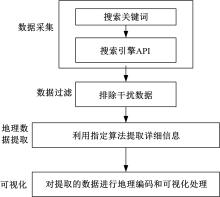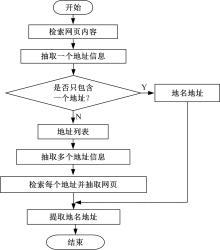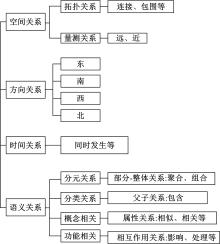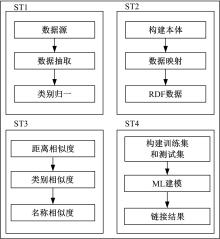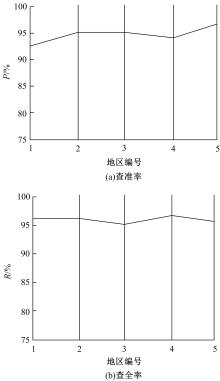Journal of Jilin University(Engineering and Technology Edition) ›› 2021, Vol. 51 ›› Issue (3): 1011-1016.doi: 10.13229/j.cnki.jdxbgxb20200113
Geospatial data extraction algorithm based on machine learning
Xiao-long ZHU1,2( ),Zhong XIE1(
),Zhong XIE1( )
)
- 1.School of Geography and Information Engineering,China University of Geosciences(Wuhan),Wuhan 430074,China
2.College of Geoscience,Yangtze University,Wuhan 430100,China
CLC Number:
- P208
| 1 | 刘学, 刘张霞. 村镇区域规划中统计数据空间化研究初探[J]. 中国农业资源与区划, 2016, 37(5):27-34. |
| Liu Xue, Liu Zhang-xia. Preliminary study on spatialization of statistical data in village and town planning[J]. Chinese Journal of Agricultural Resources and Regional Planning, 2016, 37(5):27-34. | |
| 2 | 周志光, 余佳珺, 郭智勇, 等. 平行坐标轴动态排列的地理空间多维数据可视分析[J]. 中国图象图形学报, 2019, 24(6):956-968. |
| Zhou Zhi-guang, Yu Jia-jun, Guo Zhi-yong, et al. Visual analysis of geospatial multi-dimensional data via a dynamic arrangement of parallel coordinates[J]. Journal of Image and Graphics, 2019, 24(6):956-968. | |
| 3 | 何振芳, 郭庆春, 赵牡丹, 等. 基于小波分析的复杂地貌区DEM自动综合研究[J]. 地理与地理信息科学, 2019, 35(4):57-63. |
| He Zhen-fang, Guo Qing-chun, Zhao Mu-dan, et al. Research on DEM automatic synthesis in complex geomorphic areas based on wavelet analysis[J]. Geography and Geo-Information Science, 2019, 35(4):57-63. | |
| 4 | 孙凯, 诸云强, 潘鹏, 等. 形态本体及其在地理空间数据发现中的应用研究[J]. 地球信息科学学报, 2016, 18(8):1011-1021. |
| Sun Kai, Zhu Yun-qiang, Pan Peng, et al. Research on morphology-ontology and its application in geospatial data discovery[J]. Journal of Geo-Information Science, 2016, 18(8):1011-1021. | |
| 5 | 赵红伟, 诸云强, 侯志伟, 等. 地理空间元数据关联网络的构建[J]. 地理科学, 2016, 36(8):1180-1189. |
| Zhao Hong-wei, Zhu Yun-qiang, Hou Zhi-wei, et al. Construction of geospatial metadata association network[J]. Scientia Geographica Sinica, 2016, 36(8):1180-1189. | |
| 6 | 陆旻, 袁晓如. 地理空间数据可视化中的过滤[J]. 计算机辅助设计与图形学学报, 2016, 28(5):702-711. |
| Lu Min, Yuan Xiao-ru. Filter in visualization of geospatial data[J]. Journal of Computer-Aided Design & Computer Graphics, 2016, 28(5):702-711. | |
| 7 | 邵彧, 师晓利. 基于遥感数据挖掘的智能地理信息系统设计[J]. 现代电子技术, 2016, 39(10):54-57. |
| Shao Yu, Shi Xiao-li. Design of intelligent geographic information system based on remote sensing data mining[J]. Modern Electronics Technique, 2016, 39(10):54-57. | |
| 8 | 许栋浩, 李宏伟, 张铁映, 等. 一种顾及模糊属性的空间关联规则挖掘方法[J]. 测绘科学技术学报, 2016, 33(3):313-318. |
| Xu Dong-hao, Li Hong-wei, Zhang Tie-ying, et al. A method of spatial association rule mining considering fuzzy attributes[J]. Journal of Geomatics Science and Technology, 2016, 33(3):313-318. | |
| 9 | 李德仁. 展望大数据时代的地球空间信息学[J]. 测绘学报, 2016, 45(4):379-384. |
| Li De-ren. Towards geo-spatial information science in big data era[J]. Acta Geodaetica et Cartographica Sinica, 2016, 45(4):379-384. | |
| 10 | 王东旭, 诸云强, 潘鹏,等. 地理数据空间本体构建及其在数据检索中的应用[J]. 地球信息科学学报, 2016, 18(4):443-452. |
| Wang Dong-xu, Zhu Yun-qiang, Pan Peng, et al. Construction of geodata spatial ontology and its application in data retrieval[J]. Journal of Geo-Information Science, 2016, 18(4):443-452. | |
| 11 | 王晓辉,吴禄慎,陈华伟. 基于法向量距离分类的散乱点云数据去噪[J]. 吉林大学学报:工学版,2020,50(1):278-288. |
| Wang Xiao-hui, Wu Lu-shen, Chen Hua-wei. Denoising of scattered point cloud data based on normal vector distance classification[J]. Journal of Jilin University(Engineering and Technology Edition), 2020,50(1):278-288. | |
| 12 | 丁宁,常玉春,赵健博,等. 基于USB 3.0的高速CMOS图像传感器数据采集系统[J]. 吉林大学学报:工学版,2018,48(4):1298-1304. |
| Ding Ning, Chang Yu-chun, Zhao Jian-bo, et al. High-speed CMOS image sensor data acquisition system based on USB 3.0[J]. Journal of Jilin University(Engineering and Technology Edition), 2018,48(4):1298-1304. | |
| 13 | 山海涛, 程承旗, 陈波. 一种基于GeoSOT剖分网格的地理空间数据存储架构设计方法[J]. 测绘科学技术学报, 2018, 35(3):94-97, 103. |
| Shan Hai-tao, Cheng Cheng-qi, Chen bo. A method of the storage architecture design of geospatial data based on GeoSOT[J]. Journal of Geomatics Science and Technology, 2018, 35(3):94-97, 103. | |
| 14 | 熊伟,资文杰,曹竞之. 科学工作流支持的复杂地理计算流程处理[J].武汉大学学报:信息科学版,2020,45(12):1903-1909. |
| Xiong Wei, Zi Wen-jie, Cao Jing-zhi. Complicated geospatial flow processing with scientific workflow[J]. Geomatics and Information Science of Wuhan University, 2020,45(12):1903-1909. | |
| 15 | 陈磊, 王江锋, 谷远利,等. 基于思维进化优化的多源交通数据融合算法[J]. 吉林大学学报:工学版, 2019, 49(3):705-713. |
| Chen Lei, Wang Jiang-feng, Gu Yuan-li, et al. Multi-source traffic data fusion algorithm based onmind evolutionary algorithm optimization[J]. Journal of Jilin University(Engineering and Technology Edition), 2019, 49(3): 705-713. | |
| 16 | 蔡英凤,张为公,王海.边缘特征与局部纹理特性融合的阴影消除算法[J].江苏大学学报:自然科学版,2012,33(2):144-149. |
| Cai Ying-feng,Zhang Wei-gong,Wang Hai. Shadow elimination method integrated edge features and local texture characteristic[J]. Journal of Jiangsu University(Natural Science Edition),2012,33(2):144-149. | |
| 17 | 赵慧慧,赵凡,陈仁海,等. 基于地理空间大数据的高效索引与检索算法[J]. 计算机研究与发展,2020,57(2):333-345. |
| Zhao Hui-hui, Zhao Fan, Chen Ren-hai, et al. Efficient index and query algorithm based on geospatial big data[J]. Journal of Computer Research and Development, 2020,57(2):333-345. |
| [1] | Bing-hai ZHOU,Qiong WU. Balancing and bi⁃objective optimization of robotic assemble lines [J]. Journal of Jilin University(Engineering and Technology Edition), 2021, 51(2): 720-727. |
| [2] | Xiao-hui WEI,Chang-bao ZHOU,Xiao-xian SHEN,Yuan-yuan LIU,Qun-chao TONG. Accelerating CALYPSO structure prediction with machine learning [J]. Journal of Jilin University(Engineering and Technology Edition), 2021, 51(2): 667-676. |
| [3] | Tian-qi GU,Chen-jie HU,Yi TU,Shu-wen LIN. Robust reconstruction method based on moving least squares algorithm [J]. Journal of Jilin University(Engineering and Technology Edition), 2021, 51(2): 685-691. |
| [4] | Qian-yi XU,Gui-he QIN,Ming-hui SUN,Cheng-xun MENG. Classification of drivers' head status based on improved ResNeSt [J]. Journal of Jilin University(Engineering and Technology Edition), 2021, 51(2): 704-711. |
| [5] | Xiao-yu WANG,Xin-hao HU,Chang-lin HAN. Face pencil drawing algorithms based on generative adversarial network [J]. Journal of Jilin University(Engineering and Technology Edition), 2021, 51(1): 285-292. |
| [6] | Yuan SONG,Dan-yuan ZHOU,Wen-chang SHI. Method to enhance security function of OpenStack Swift cloud storage system [J]. Journal of Jilin University(Engineering and Technology Edition), 2021, 51(1): 314-322. |
| [7] | Ming FANG,Wen-qiang CHEN. Face micro-expression recognition based on ResNet with object mask [J]. Journal of Jilin University(Engineering and Technology Edition), 2021, 51(1): 303-313. |
| [8] | Yang LI,Shuo LI,Li-wei JING. Estimate model based on Bayesian model and machine learning algorithms applicated in financial risk assessment [J]. Journal of Jilin University(Engineering and Technology Edition), 2020, 50(5): 1862-1869. |
| [9] | Bing-hai ZHOU,Zhao-xu HE. Dynamic material handling scheduling for mixed⁃model assembly lines based on line⁃integrated supermarkets [J]. Journal of Jilin University(Engineering and Technology Edition), 2020, 50(5): 1809-1817. |
| [10] | Lei JIANG,Ren-chu GUAN. Design of fuzzy comprehensive evaluation system for talent quality based on multi⁃objective evolutionary algorithm [J]. Journal of Jilin University(Engineering and Technology Edition), 2020, 50(5): 1856-1861. |
| [11] | Hong-wei ZHAO,Xiao-han LIU,Yuan ZHANG,Li-li FAN,Man-li LONG,Xue-bai ZANG. Clothing classification algorithm based on landmark attention and channel attention [J]. Journal of Jilin University(Engineering and Technology Edition), 2020, 50(5): 1765-1770. |
| [12] | Nai-yan GUAN,Juan-li GUO. Component awareness adaptive model based on attitude estimation algorithms [J]. Journal of Jilin University(Engineering and Technology Edition), 2020, 50(5): 1850-1855. |
| [13] | Wei FANG,Yi HUANG,Xin-qiang MA. Automatic defect detection for virtual network perceptual data based on machine learning [J]. Journal of Jilin University(Engineering and Technology Edition), 2020, 50(5): 1844-1849. |
| [14] | Xiang-jiu CHE,You-zheng DONG. Improved image recognition algorithm based on multi⁃scale information fusion [J]. Journal of Jilin University(Engineering and Technology Edition), 2020, 50(5): 1747-1754. |
| [15] | Zhou-zhou LIU,Wen-xiao YIN,Qian-yun ZHANG,Han PENG. Sensor cloud intrusion detection based on discrete optimization algorithm and machine learning [J]. Journal of Jilin University(Engineering and Technology Edition), 2020, 50(2): 692-702. |
|
||
